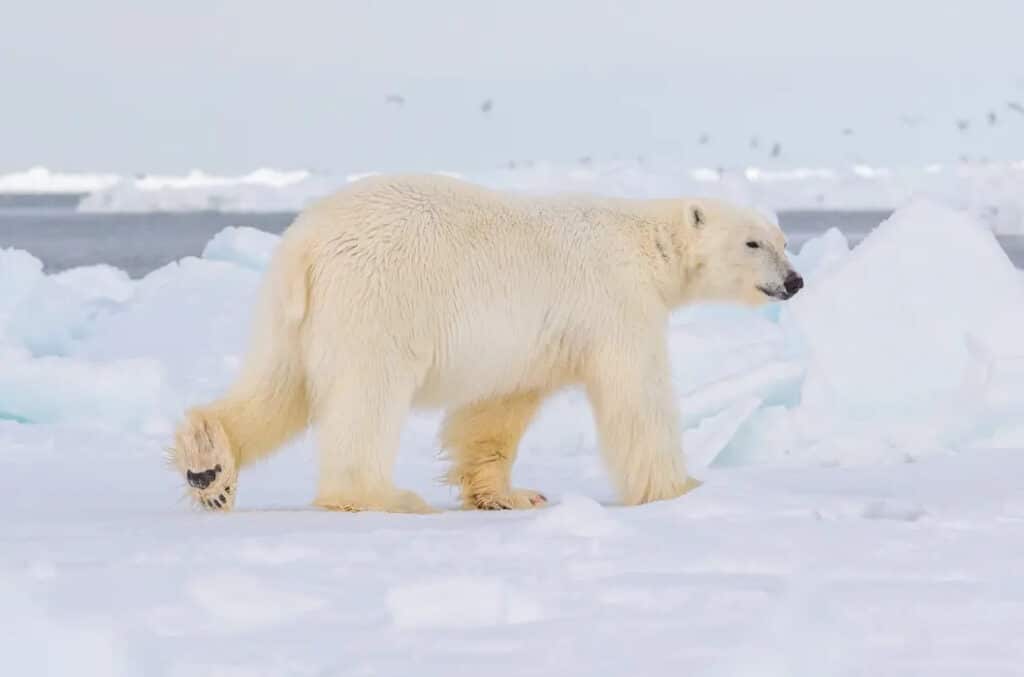Dr. Melanie Lancaster of the World Wide Fund for Nature Global Arctic Programme collects snow containing paw prints at Svalbard, Norway. Micaela Hellstrom / MIX Research Sweden AB
 Why you can trust us
Why you can trust us
Founded in 2005 as an Ohio-based environmental newspaper, EcoWatch is a digital platform dedicated to publishing quality, science-based content on environmental issues, causes, and solutions.
Polar bears can be elusive and difficult to track in the wild, but scientists have come up with a new, noninvasive way to follow them — as well as other animals like snow leopards and Eurasian lynxes — using environmental DNA (eDNA) extracted from skin cells shed inside their paw prints in the snow.
Monitoring the detailed movements of polar bear populations and other threatened species is essential for their protection and conservation. However, since they can be hard to find, crucial data regarding population size and connectivity between populations has been missing, according to a new study by the World Wildlife Fund (WWF) and MIX Research Sweden AB.
“It is particularly challenging, expensive, and time-consuming to find polar bears in the Arctic, let alone count them and understand how they are coping with climate change,” said Dr. Melanie Lancaster, senior author of the study who is also Arctic species senior specialist for the World Wide Fund for Nature Global Arctic Programme, as Frontiers reported.

A Polar bear near Utqiagvik, Alaska. Elisabeth Kruger / World Wildlife Fund
The scientists at the MIX Research lab were able to isolate and sequence eDNA from the nuclei of bears’ cells left behind in their paw prints, which allowed the researchers to put together a unique genetic profile for each bear, a press release from WWF said. This will enable further understanding of behavioral and migratory patterns, as well as population interconnectedness.
The study, “Capturing environmental DNA in snow tracks of polar bear, Eurasian lynx and snow leopard towards individual identification,” was published in the journal Frontiers in Conservation Science.
The researchers were inspired in their data collection by forensic methods which can be used with tiny samples of DNA even when they have been degraded, reported Frontiers.
The techniques enable scientists to study bears without physically capturing them, which is a concern for some Indigenous communities and is also stressful and dangerous for bears and humans.
“Many Inuit express concern about invasive research methods,” said Elisabeth Kruger, co-author of the study and manager of WWF’s Arctic Wildlife Program, as Frontiers reported. “People are concerned about the welfare of the individual polar bear and the health and safety of people who may harvest the bear later. This is one of the reasons we are so excited about new methods like this – the person collecting the sample never needs to even see or be seen by the polar bear.”
Environmental DNA can be found when animals defecate, but that form of eDNA isn’t always of a good enough quality to do the individual analysis necessary for conservation.
More From EcoWatch
The behavior of territorial animals like snow leopards and lynxes can also be affected by collecting feces samples, so the research team opted for samples from their snowy paw prints instead.
“The tracks usually contain fresh cells, and the DNA is intact because of the cold ‘storage’ temperature. DNA that has passed the gut is much more degraded and therefore more challenging to work on,” said lead author of the study Dr. Micaela Hellström of MIX Research Sweden, as reported by Frontiers.
The team collected snow samples from tracks made by individual polar bears in Alaska and Eurasian lynxes in Sweden both in the wild and in captivity, as well as from tracks of a snow leopard in captivity. They also sampled materials like saliva, hair and mucus, which confirmed that the tracks were giving them accurate genotypes.
A total of 24 tracks from wild polar bears and 44 from wild lynx were sampled by the researchers. In order to collect the eDNA, they melted then filtered snow before conducting a microsatellite analysis. Despite the fact that concentrations of eDNA were low, the research team was able to successfully extract nuclear DNA from 59.1 percent of the wild lynx tracks and 87.5 percent of those made by the wild polar bears. Of the samples from wild polar bears, 13 were able to be genotyped, which allowed for the identification of 12 distinct individuals.
Eleven percent of the wild lynx tracks were able to be genotyped, but this number rose to 76 percent when the researchers looked only at the tracks that had been sampled by trained personnel. Of those, 24 percent were able to be genotyped.
The new method of collecting eDNA has great potential for understanding the behavior and populations of these exquisite yet elusive animals, while also informing conservation and managing human-wildlife conflicts through the use of accurate animal identification. Even though the sampling technique has a lower success rate, the fact that it is noninvasive means sample sizes can be greatly expanded.
“We hope this method will be taken up by the polar bear research community, with the involvement of hunters, volunteers, and Indigenous communities, as a new way to collect information on polar bears,” Lancaster said, as Frontiers reported. “We also hope the method will be expanded to other animals living in snowy environments — we have shown it works for lynx and snow leopards as a start.”
Subscribe to get exclusive updates in our daily newsletter!
By signing up, you agree to the Terms of Use and Privacy Policy & to receive electronic communications from EcoWatch Media Group, which may include marketing promotions, advertisements and sponsored content.
